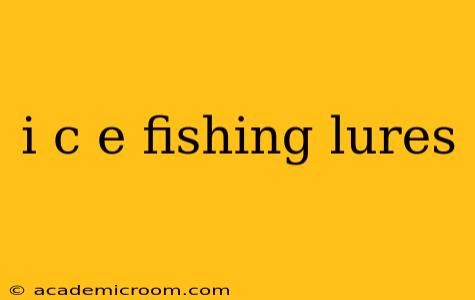Ice fishing, a winter pastime enjoyed by many, requires specialized techniques and equipment to succeed. Choosing the right lure is paramount to attracting fish beneath the frozen surface. This comprehensive guide explores various ice fishing lures, their effectiveness, and how to use them to maximize your catch.
What are the Best Ice Fishing Lures?
The "best" ice fishing lure depends heavily on the target species, water conditions, and personal preference. However, some lures consistently perform well and are popular among ice anglers. These include:
-
Jigs: These are arguably the most versatile ice fishing lures. They come in a wide array of sizes, weights, colors, and styles (e.g., tungsten jigs, lead jigs, plastic jigs). Their versatility allows anglers to adapt to different situations and target various fish species.
-
Spoons: Spoons are another staple in ice fishing. Their metallic construction and shimmering action attract fish with their flash and vibration. They come in various sizes and shapes, each designed to mimic different baitfish.
-
Plastic Grubs and Tubes: Soft plastics are excellent ice fishing lures. Their lifelike movements and ability to be rigged with jigs enhance their appeal to fish. The soft material also provides a more natural feel, resulting in more confident bites.
-
Baitfish Imitations: These lures replicate the appearance and movement of smaller fish that predatory fish feed on. These can be hard or soft and are particularly effective for targeting larger species.
What are the Different Types of Ice Fishing Lures?
Beyond the basic categories above, various types of ice fishing lures are designed for specific scenarios.
-
Glow-in-the-dark lures: These are highly effective in low-light conditions, attracting fish even in deep water or during overcast days.
-
Flutter spoons: Their unique shape creates an erratic, fluttering motion in the water, which can be highly attractive to fish.
-
Micro jigs and spoons: These smaller versions are ideal for targeting smaller fish or when fish are finicky.
-
Lures with rattle chambers: These incorporate internal rattles to produce sound, attracting fish from a distance.
What is the Best Color for Ice Fishing Lures?
Color selection in ice fishing can be crucial. The best color often depends on water clarity and light conditions.
-
Clear water: In clear water, natural colors like silver, gold, or clear with subtle patterns tend to perform best.
-
Murky water: In murkier water, brighter colors like chartreuse, orange, or red are more visible and effective.
However, experimentation is key, as fish preferences can vary depending on the location, time of day, and even the specific fish species.
What Size Ice Fishing Lure Should I Use?
The ideal lure size is directly related to the size of the target fish. Larger lures are needed for larger fish, while smaller lures are better for attracting smaller fish. Consider the species and size of fish in the particular water body when choosing the appropriate lure.
How to Use Ice Fishing Lures Effectively?
Effective lure presentation is key to success. This involves:
-
Understanding the behavior of your target fish: Research the feeding habits of the species you're targeting to choose the most effective lure.
-
Proper jigging technique: This involves a combination of lifts, drops, and pauses to create an enticing action. Experiment with different techniques to determine what works best.
-
Varying retrieval speeds: Change the pace of your lure's movement to trigger a strike. Sometimes a slow, deliberate retrieve works best, while other times, a faster retrieve can be more effective.
-
Using scent attractants: Applying scent to your lure can significantly enhance its effectiveness, especially in colder water where fish's sense of smell is heightened.
What is the Best Material for Ice Fishing Lures?
Ice fishing lures are commonly constructed from various materials, each with advantages and disadvantages:
-
Tungsten: Offers excellent weight-to-size ratio, making it ideal for finesse jigging and reaching deeper depths.
-
Lead: More affordable, but less sensitive to subtle movements.
-
Brass: A durable and versatile choice offering a slightly different action than lead or tungsten.
-
Plastic: Provides excellent flexibility and allows for realistic designs and intricate detail.
Ultimately, the best material depends on your specific needs and preferences.
This comprehensive guide provides a solid foundation for choosing and using ice fishing lures. Remember, experimentation and adapting to changing conditions are crucial for success on the ice. Happy fishing!
